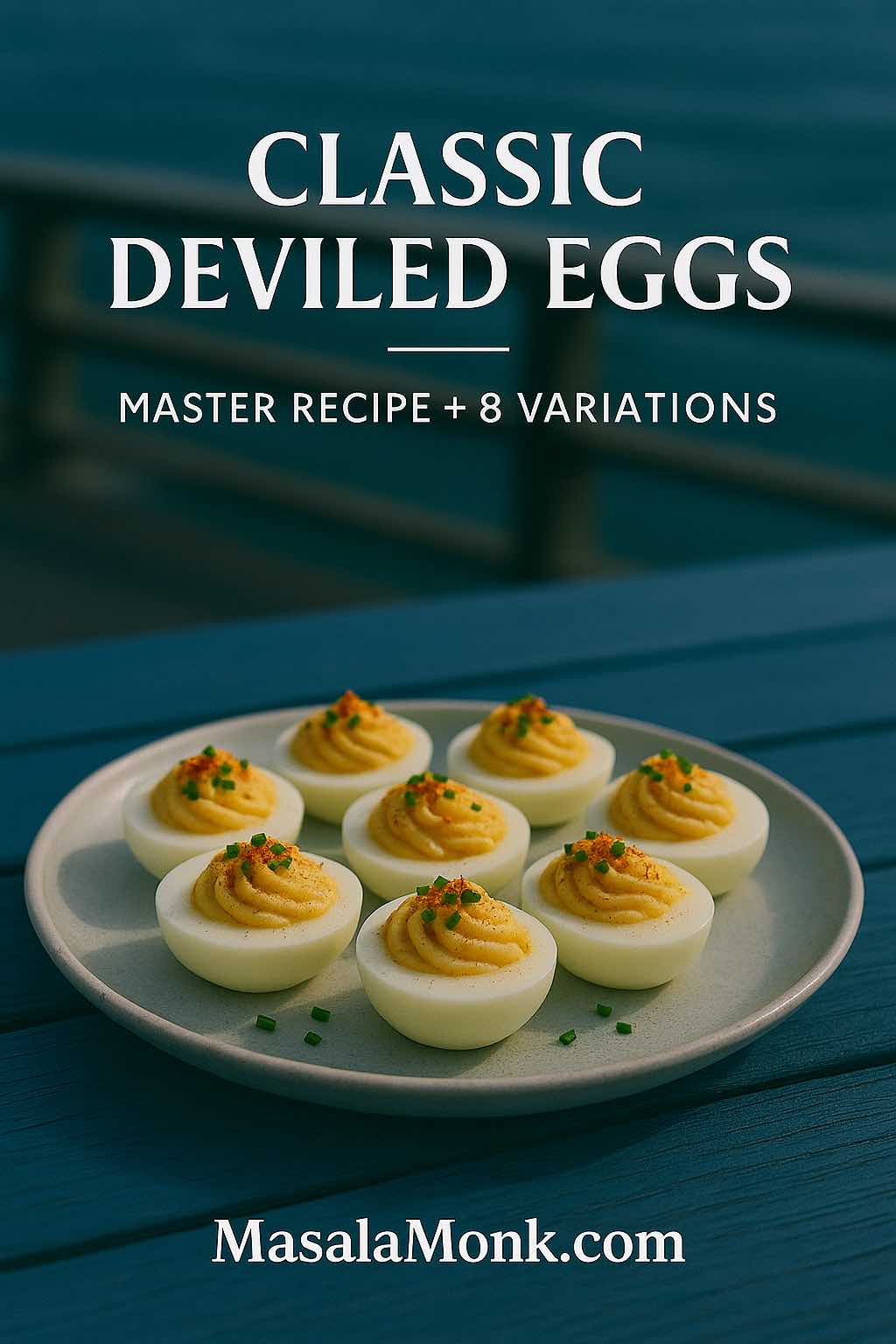
There’s a reason classic deviled eggs are the platter that empties first. They’re simple, yes, but they’re also quietly perfect: a tender white that cradles a plush, tangy filling; a dusting of paprika that looks like confetti; a garnish that promises exactly what you’re about to taste. They travel well, they scale easily, and they make friends at every table—from potlucks to weddings to sleepy Sunday brunch. Most of all, they invite tinkering, so after you master the base, you can tilt the flavor toward briny, herby, smoky, or spicy without losing the comfort of the original.
Today, you’ll get a dependable classic deviled eggs recipe that scales cleanly, plus eight variations that read as real, distinct ideas rather than tiny tweaks. Along the way, you’ll see why cooking method matters, how a brief whisk transforms texture, and where tiny adjustments in acid and salt make magic. If you want seasoning inspiration while you read, take a quick spin through MasalaMonk’s friendly roundup, Egg-cellent Seasoning Options for Flavorful Eggs; it’s full of small, confident nudges. For paprika style and color sense, Elevate Your American Cooking is a quick primer. And for a clear demonstration of the steam method (which often peels easier), the step-by-step at Serious Eats helps: Steamed Hard-Boiled Eggs. Finally, because we all host in the real world, the FDA’s plain-English refresher on time and temperature is worth a single, sensible link: Egg Safety.
The quiet mechanics of great deviled eggs
Before we cook, it helps to know what we’re chasing. First, texture: you want smooth whites without moon-craters and a filling that’s plush, pipeable, and light. Therefore, a hot-start boil or a gentle steam—followed by an aggressive ice bath—works in your favor. Because heat sets the albumen from the outside in, starting hot contracts the membrane early; consequently, shells slip off with less drama, and yolks stay sunny instead of green-rimmed.
Second, balance: every bite needs a little fat (mayo), a little heat (mustard, pepper, or both), and a little acid (vinegar or pickle brine). Since flavors pop faster in a silky puree, you add acid by drops and salt by pinches, tasting as you go; as a result, you land in that bright, savory zone that makes people reach back to the platter without thinking.
Third, finish: garnish isn’t decoration so much as a promise. Dill signals pickle; celery leaf whispers buffalo; tarragon says French; chives nod toward ranch; bacon speaks for itself. Meanwhile, a gentle snowfall of paprika acts like lighting—softening edges and adding warmth without hiding the swirl.
Also Read: Eating Boiled Eggs at Night: Benefits, Side Effects & Weight Loss Tips
Master Recipe: Classic Deviled Eggs
Yield: 12 halves (serves 4–6 as an appetizer)
Total time: about 30 minutes (including a short chill)
Ingredients
- 6 large eggs
- 4–5 Tbsp mayonnaise (start with 4; hold 1 to adjust texture)
- 1 tsp yellow or Dijon mustard
- 1 tsp white vinegar or pickle juice
- Fine salt and freshly ground black pepper
- Sweet or smoked paprika, for finishing
- Optional: snipped chives or fresh dill
Scaling ratio (per whole egg → 2 halves):
1 yolk + 1½ tsp mayo + ⅛ tsp mustard + ⅛ tsp acid + pinch salt & pepper.
Because that ratio is easy to remember, you can scale from a snack for two to a party tray without doing math on your phone mid-peel.
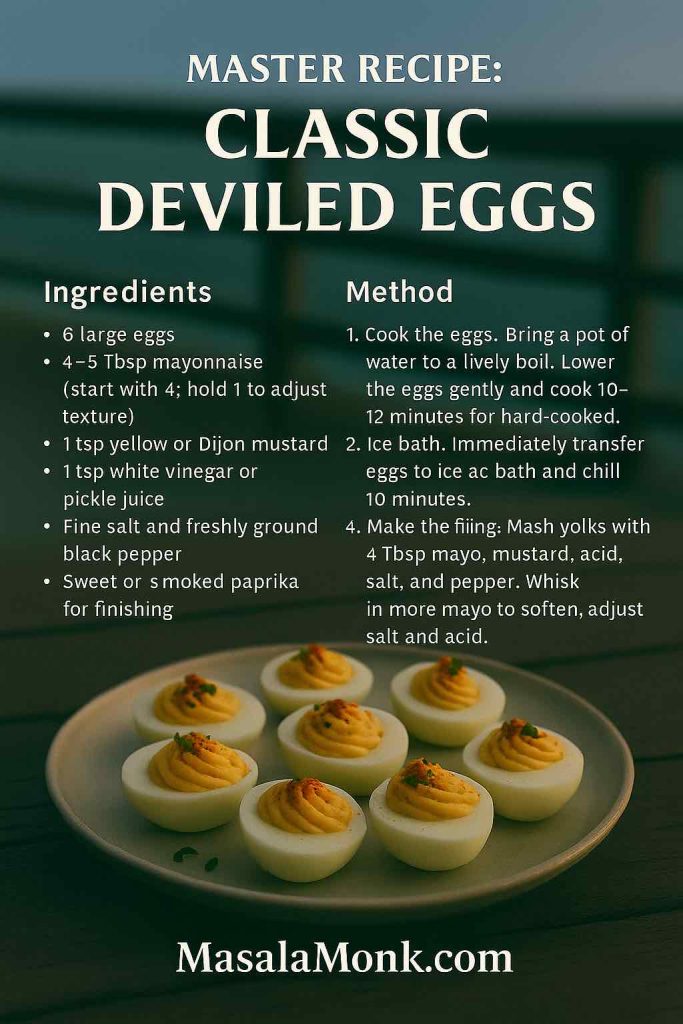
Method
- Cook the eggs. Bring a pot of water to a lively boil. Lower the eggs gently and cook 10–12 minutes for hard-cooked. (Alternatively—and often more peel-friendly—steam eggs over simmering water for ~12 minutes; if you want a visual, the walkthrough at Steamed Hard-Boiled Eggs is clear and kind.)
- Ice bath. Immediately transfer eggs to an ice bath and chill 10 minutes. In practice, this interrupts carryover cooking and helps the membrane release; consequently, peels behave.
- Peel. Tap all over, roll gently to web the shell, then peel from the wide end where the air pocket sits. If you hit a stubborn spot, peel under water; it sneaks under the membrane.
- Halve and collect yolks. Slice lengthwise. Pop yolks into a bowl; set whites cut-side up on a platter. If they’re sliding, line the platter with a paper towel while you work and remove it before serving.
- Make the filling. Add 4 Tbsp mayo, mustard, vinegar or pickle juice, a pinch of salt, and a few grinds of pepper to the yolks. First mash very smooth with a fork; then whisk 30–60 seconds until the mixture looks glossy and plush. Taste. If you want a softer swirl, add the remaining tablespoon of mayo. Adjust acid drop by drop and salt to taste.
- Fill. Spoon the filling back into the whites, or pipe from a small bag with the corner snipped (set the bag in a tall glass to fill neatly; then twist and burp air).
- Finish and chill. Dust lightly with paprika; add chives or dill if you like. Finally, chill 10–20 minutes so the tops set and the tray travels as well as it tastes.
Also Read: Egg Intolerance Symptoms
Why this base is so forgiving
Because the base is conservative on liquid, the filling stays sturdy enough to pipe crisply; because a short whisk aerates without adding water, the texture reads decadent rather than dense. Meanwhile, that easy ratio means your hands remember it, which—in a real kitchen, at a real hour—creates confidence. Moreover, since we season late and in tiny increments, you can walk flavor right to the edge without tipping it over. If you want to extend the spice conversation—cayenne, onion powder, mustard powder, smoked paprika—MasalaMonk’s list is helpful and relaxed: Egg-cellent Seasoning Options for Flavorful Eggs. And if you’re deciding between sweet, hot, and smoked paprika—and how each reads on the plate—this quick primer will save you a few experiments: Elevate Your American Cooking.
Scaling (US & metric that won’t betray you mid-party)
| Whole Eggs | Yolks | Mayo | Mustard | Acid | Fine Salt | Yield |
|---|---|---|---|---|---|---|
| 4 | 4 | 6 tsp / ~30 g | ½ tsp | ½ tsp | ¼ tsp | 8 halves |
| 6 | 6 | 9 tsp / ~45 g | ¾ tsp | ¾ tsp | ⅜ tsp | 12 halves |
| 10 | 10 | 15 tsp / ~75 g | 1¼ tsp | 1¼ tsp | ⅝ tsp | 20 halves |
| 12 | 12 | 18 tsp / ~90 g | 1½ tsp | 1½ tsp | ¾ tsp | 24 halves |
| 24 | 24 | 36 tsp / ~180 g | 3 tsp | 3 tsp | 1½ tsp | 48 halves |
For very large batches, weigh the mayo and whisk briefly in a wide bowl—or on a mixer’s lowest speed for 20–30 seconds—so the filling emulsifies evenly without going slack. Then pause. Because you can always loosen with a few drops of acid or water, restraint keeps you in control.
Troubleshooting you’ll actually use
- Too stiff? Add ½ tsp liquid (pickle juice, vinegar, or water) and whisk. Repeat if you must, but slowly.
- Too loose? Mash in an extra cooked yolk if you have one; otherwise, chill 10 minutes and reassess.
- Grainy? Press through a fine mesh sieve, then whisk 20 seconds.
- Flat flavor? Add a tiny pinch of salt and a few drops of acid; dust with paprika.
- Whites tearing? Chill longer; next time, steam the eggs and use eggs that aren’t ultra-fresh.\
Also Read: Egg Yolks or Yellow: Nutritional & Protein Profile
Eight variations (fully detailed, distinct, and platter-friendly)
Each variation starts with the master filling at Step 5. Because the base is balanced, you can layer flavor confidently, yet the texture remains classic.
1) Dill Pickle & Brine Deviled Eggs
Add to filling
- 2 Tbsp finely chopped dill pickles
- Replace vinegar with 1–2 tsp pickle juice
- 1 Tbsp fresh dill, finely chopped (optional)
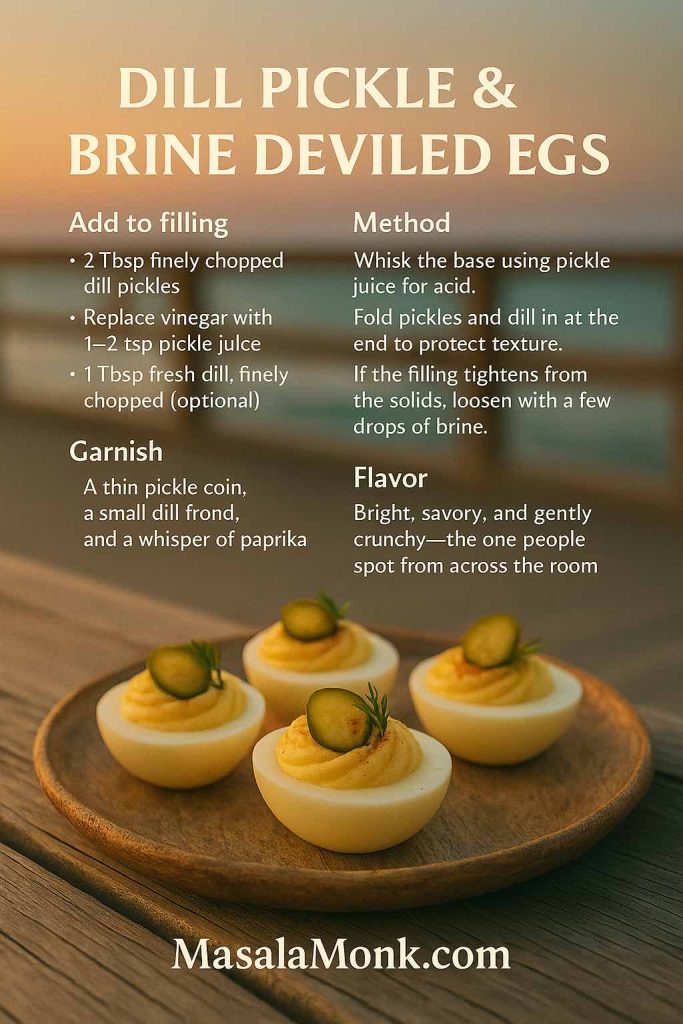
How to do it
Whisk the base using pickle juice for acid. Fold pickles and dill in at the end to protect texture. If the filling tightens from the solids, loosen with a few drops of brine.
Garnish
A thin pickle coin, a small dill frond, and a whisper of paprika.
Flavor
Bright, savory, and gently crunchy—the one people spot from across the room.
Further seasoning ideas? Stroll through Egg-cellent Seasoning Options for Flavorful Eggs for easy pinches that lean into the briny theme.
2) Ranch Deviled Eggs
Add to filling
- 1–2 tsp dry ranch seasoning
- 1–2 tsp water or buttermilk only if needed
- Snipped chives
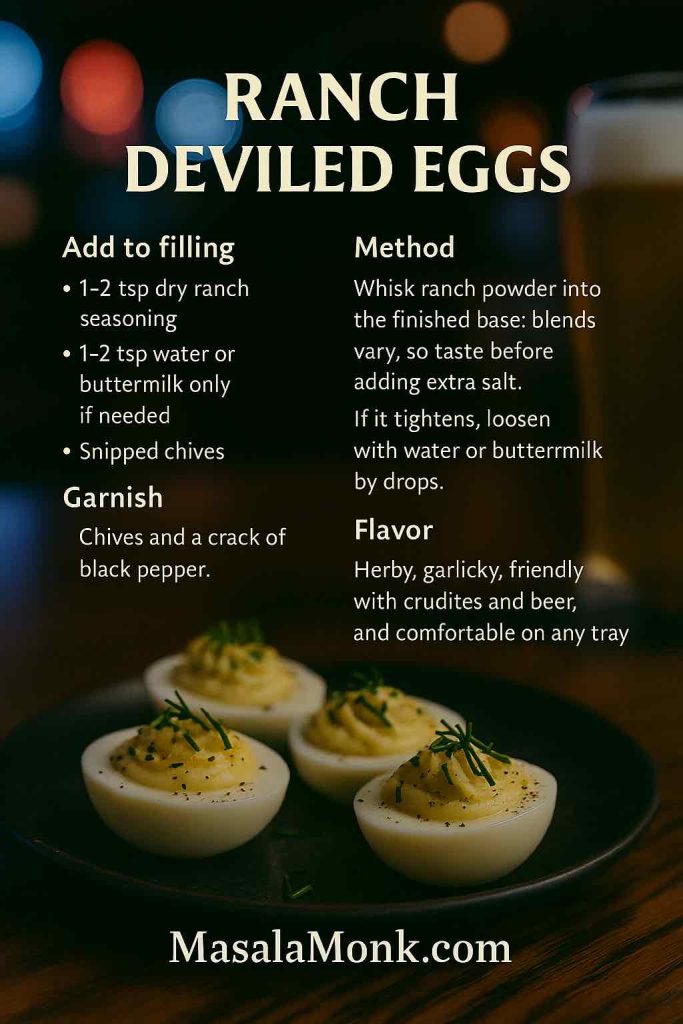
How to do it
Whisk ranch powder into the finished base; blends vary, so taste before adding extra salt. If it tightens, loosen with water or buttermilk by drops.
Garnish
Chives and a crack of black pepper.
Flavor
Herby, garlicky, friendly with crudités and beer, and comfortable on any tray.
Also Read: Are Expensive Eggs Worth Your Money? Guide to Choosing Eggs
3) Buffalo Deviled Eggs
Add to filling
- 1–2 tsp vinegary hot sauce (Frank’s-style)
- Optional ½ tsp melted butter for roundness
- Optional micro blue cheese crumble
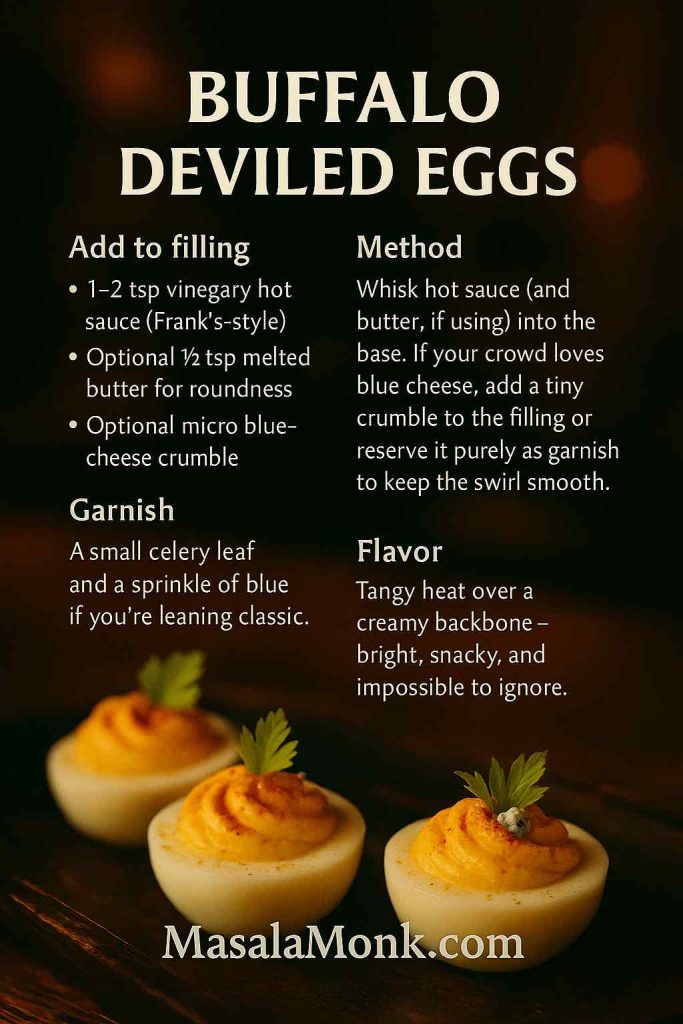
How to do it
Whisk hot sauce (and butter, if using) into the base. If your crowd loves blue cheese, add the tiniest crumble to the filling or reserve it purely as garnish so the swirl stays smooth.
Garnish
A small celery leaf and a sprinkle of blue if you’re leaning classic.
Flavor
Tangy heat over a creamy backbone—like wings night and brunch met in the middle.
4) French Dijon & Fines Herbes Deviled Eggs
Swap + add
- Dijon instead of yellow mustard
- White wine vinegar instead of plain vinegar
- 1–2 tsp fines herbes (parsley, chives, tarragon; very finely chopped)
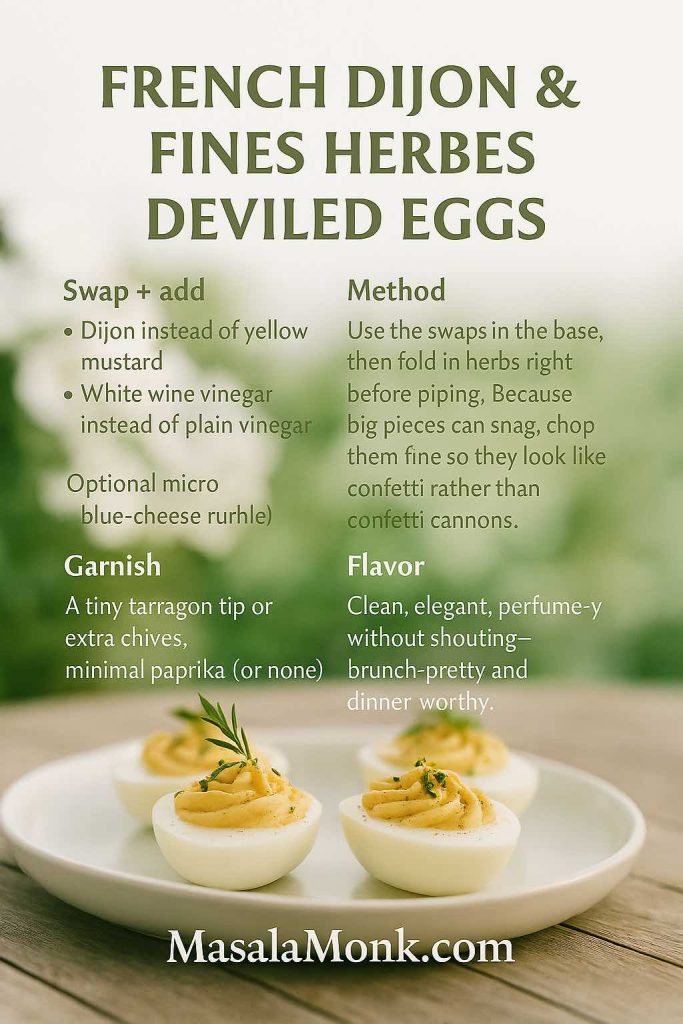
How to do it
Use the swaps in the base, then fold in herbs right before piping. Because big pieces can snag, chop them fine so they look like confetti rather than confetti cannons.
Garnish
A tiny tarragon tip or extra chives; minimal paprika (or none).
Flavor
Clean, elegant, perfume-y without shouting—brunch-pretty and dinner-worthy.
Also Read: Eggs Benedict: Desi Twist Challenge
5) Bacon & Chive Deviled Eggs
Add to filling
- 2 Tbsp very crisp bacon, finely crumbled
- 1 Tbsp chives, snipped
- Optional: replace 1 Tbsp of mayo with sour cream for extra fluff
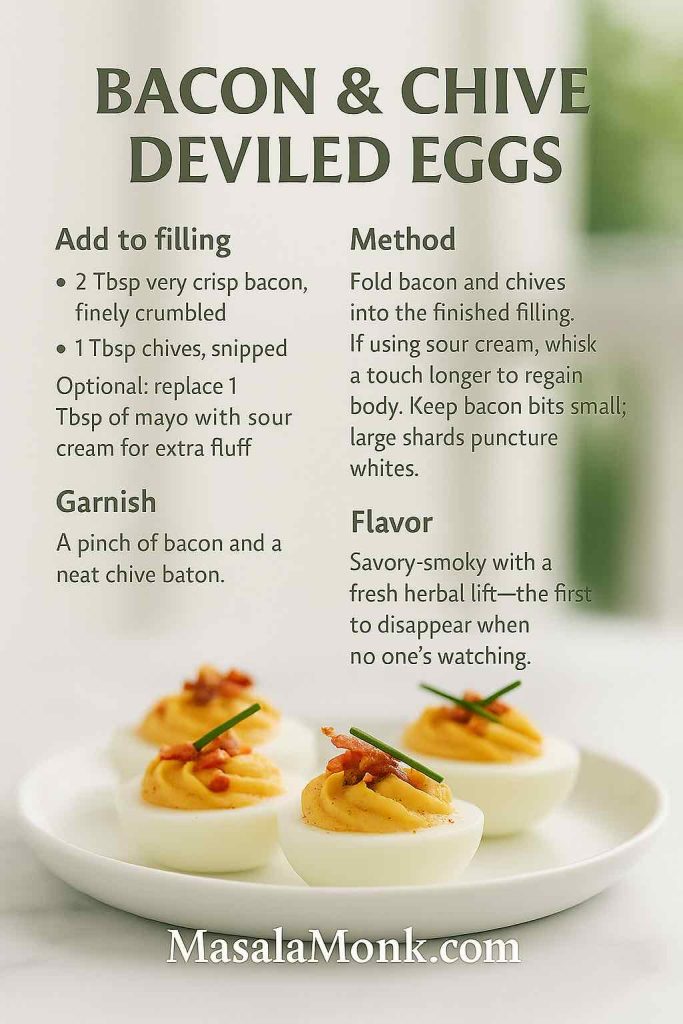
How to do it
Fold bacon and chives into the finished filling. If using sour cream, whisk a touch longer to regain body. Keep bacon bits small; large shards puncture whites.
Garnish
A pinch of bacon and a neat chive baton.
Flavor
Savory-smoky with a fresh herbal lift—the first to disappear when no one’s watching.
Also Read: 5 Creative Ideas for Bacon-Wrapped Potatoes
6) Sweet Southern Relish Deviled Eggs
Add to filling
- 1–2 Tbsp sweet pickle relish, very well-drained
- Optional ¼–½ tsp sugar dissolved in a few drops vinegar for that church-social finish
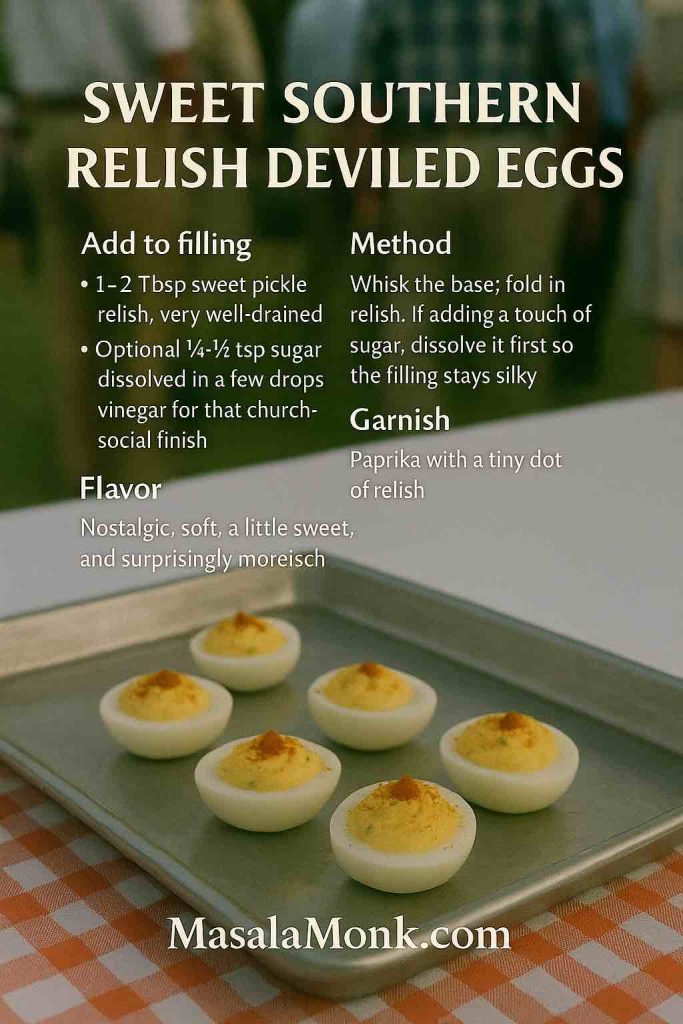
How to do it
Whisk the base; fold in relish gently. If adding a touch of sugar, dissolve it first so the filling stays silky.
Garnish
Paprika with a tiny dot of relish.
Flavor
Nostalgic, soft, a little sweet, and surprisingly moreish.
7) Sour-Cream & Onion Deviled Eggs
Swap + add
- Replace ⅓ to ½ of the mayo with sour cream
- ½–1 tsp onion powder or 1–2 tsp very finely grated onion (squeezed dry)
- Thin scallion rings
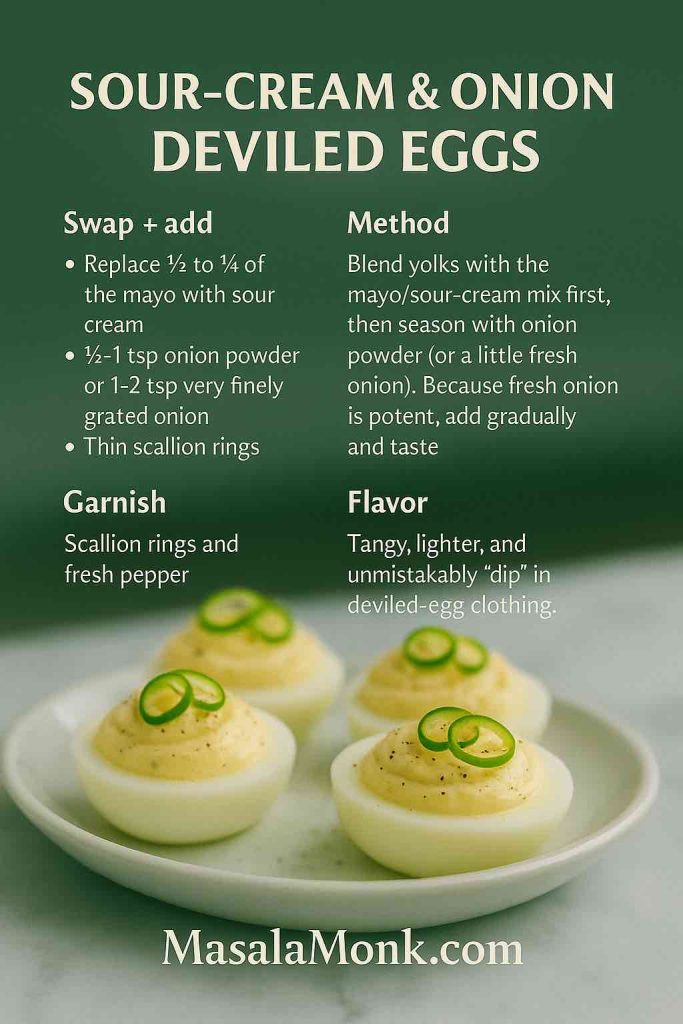
How to do it
Blend yolks with the mayo/sour-cream mix first, then season with onion powder (or a little fresh onion). Because fresh onion is potent, add gradually and taste.
Garnish
Scallion rings and fresh pepper.
Flavor
Tangy, lighter, and unmistakably “dip” in deviled-egg clothing.
Also Read: Is Sour Cream a Good Choice for Keto? Exploring Its Creamy Goodness on a Low-Carb Journey
8) Smoky Paprika or Chipotle Deviled Eggs
Add to filling
- ½–1 tsp smoked paprika or ½–1 tsp very finely minced chipotle in adobo
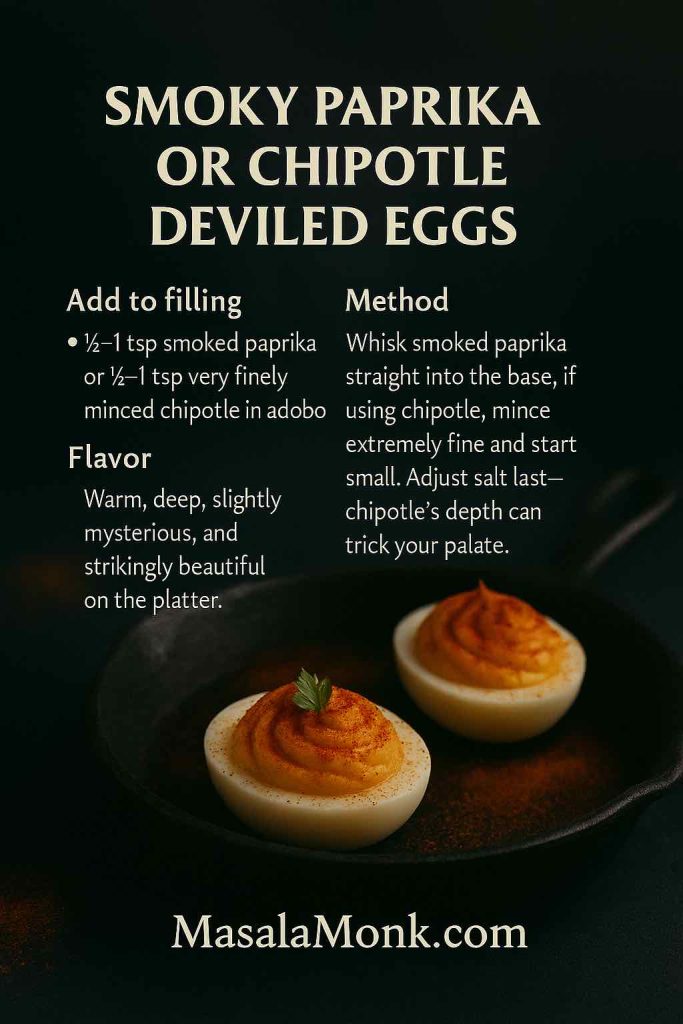
How to do it
Whisk smoked paprika straight into the base; if using chipotle, mince extremely fine and start small. Adjust salt last—chipotle’s depth can trick your palate.
Garnish
Extra smoked paprika and a small parsley leaf.
Flavor
Warm, deep, slightly mysterious, and strikingly beautiful on the platter.
Curious about paprika styles? A quick skim here will help you choose by color and heat: Elevate Your American Cooking.
Make-ahead, storage, and transport (real-life logistics)
Two days ahead: Cook and peel up to 48 hours in advance. Store whites and filling separately. Layer whites between paper towels in a covered container; press plastic wrap directly onto the surface of the filling before lidding. Consequently, you avoid crusting and keep whites satin-smooth.
On the day: Assemble within 4 hours of serving so the swirls stay glossy and the paprika doesn’t bloom in condensation. If you’re plating outside, keep a small cooler nearby; that way, refreshing the tray is easy.
At the table: Keep the platter cold. If the party runs long, rotate a second chilled tray and return the first to the fridge. For a simple, sane reminder on timing, temperature, and leftovers, the FDA’s page is short and useful: What You Need to Know About Egg Safety.
Transport: Easiest of all, carry whites and filling separately and pipe on arrival—zero smears. Otherwise, chill pre-filled halves until the tops set, then pack snugly with minimal headspace. If you line the container with a lightly damp paper towel, the whites won’t skate around during the ride.
Plating that invites people in
Because we eat with our eyes first, presentation isn’t fussy—it’s welcoming. Try a classic ring on a white platter with an even paprika halo and a light snowfall of chives. Or, build a garden board with celery sticks, cucumbers, radishes, and gentle herbs; ranch and dill versions feel at home there. For the briny crowd, create a pickle party: ring the eggs with cornichons, dill spears, and a bowl of pickled onions so people can build little bites. Meanwhile, brunch loves bacon & chive beside crisp hash browns and toast soldiers. If you’re serving a crowd, consider a mixed trio per tray—classic, herby/briny, and spicy/smoky—with distinct garnishes so guests can choose at a glance.
Naturally, platters don’t live alone. If you’d like to anchor the table with sturdy companions, point readers to MasalaMonk’s snackable ideas that genuinely fit: 10 Potato Appetizers Ideas You Will Never Imagine and 5 Sweet Potato Appetizers Ideas to Inspire the Chef in You. And if you’ve boiled a few extra eggs, send cooks straight to quick inspiration: 10 Examples of Egg Dishes, with 2 Eggs.
Serving sizes and party math (so you never come up short)
For a mixed appetizer spread, plan 2–3 halves per person; if classic deviled eggs are the star (or your people are egg people), lean toward 4 halves. A standard dozen eggs (24 halves) satisfies 8–12 with other options or 6–8 among superfans. If you’re making two trays, lead with classic, dill pickle & brine, and smoky paprika, then follow with ranch, buffalo, and bacon & chive. Consequently, you’ll cover mild, briny, and bold without repeating yourself.
When scaling beyond 12 eggs, weigh the mayo, stick to the ratio, and whisk briefly on a mixer’s lowest speed—stop the moment the filling looks glossy and holds ridges. Then chill a few minutes and pipe. Because restraint is your friend, you can always loosen with a drop or two of acid; you can’t un-thin a bowl of filling.
Also Read: Punch with Pineapple Juice: Guide & 9 Party-Perfect Recipes
Technique notes cooks actually care about
- Egg size and timing: Large eggs are the assumed standard here. If you’re using extra-large eggs, add a minute; if medium, subtract a minute.
- Altitude: At altitude, water boils lower; therefore, add 1–2 minutes to the cook time and keep that ice bath honest.
- Older vs. fresh eggs: Older peel easier; very fresh can be stubborn. Consequently, if all you’ve got is farm-fresh, steam them.
- Color cues: A green ring around the yolk isn’t dangerous; it’s overcooked. Ice baths help prevent that.
- Piping tips: A plain snip gives rustic peaks; a star tip gives height and texture; a French star gives tidy ridges that catch paprika beautifully.
- Garnish discipline: Less is more. Place the herb where it makes sense: dill for pickle, celery leaf for buffalo, tarragon for French, chives for ranch, bacon for—well—bacon.
Concluding it all
Here’s the truth: classic deviled eggs are less about perfection and more about care. You boiled water; you shocked eggs; you mashed and seasoned and tasted; you piped little swirls that look like you meant it. That intention shows. Guests notice when food feels calm and confident, and they lean in when there’s just enough variety to make choosing fun. So make the base once, then make it yours—tilt it toward dill for the cousin who loves pickles, nudge it toward Dijon and herbs for the friend who wears linen, drift it toward buffalo for the crew who cheer at the TV. And when the platter comes back empty—and it will—smile, because you did a simple thing well.
If you want to keep playing, wander a little: try a dusting of smoked paprika after chilling for deeper color; or set two tiny bowls next to the tray—one with extra pickle chips, one with chives—so people can customize their second pass. Meanwhile, if you’re planning a bigger spread, these two MasalaMonk roundups fit right beside deviled eggs without stealing the spotlight: 10 Potato Appetizers Ideas You Will Never Imagine and 5 Sweet Potato Appetizers Ideas to Inspire the Chef in You. Finally, for a clear, friendly technique refresher anytime, the steam method steps are here when you need them: Steamed Hard-Boiled Eggs. And because good hosting is also safe hosting, one bookmark for your kitchen drawer: Egg Safety.
Now breathe. Plate the eggs. Watch the tray empty. Then take your quiet bow.
FAQs
1. What are classic deviled eggs, exactly?
Classic deviled eggs are hard-cooked eggs halved and filled with a creamy yolk mixture seasoned with mayonnaise, mustard, a touch of acid (vinegar or pickle brine), salt, pepper, and usually paprika. In short, they’re simple, savory, and endlessly adaptable.
2. What’s the master ratio for classic deviled eggs?
Per 1 egg (2 halves): 1 yolk + 1½ tsp mayo + ⅛ tsp mustard + ⅛ tsp acid + a pinch of salt and pepper. Because that ratio scales cleanly, you can multiply straight across for 4, 6, 10, 12, or even 24 eggs without fuss.
3. Should I boil or steam the eggs?
Both work; however, steaming is often more forgiving and peels more cleanly. Either way, immediately shock in ice water for 10 minutes so shells release easily and yolks stay sunny.
4. How do I peel eggs without tearing the whites?
First, crack all over and roll gently; then start from the wide end where the air pocket sits. If a spot resists, peel under water—consequently, the membrane loosens and the peel slips away.
5. How long do hard-cooked eggs last in the fridge?
Generally, up to 7 days when kept refrigerated. That said, once you mix the filling, aim to enjoy your classic deviled eggs within 2–3 days for the best texture and flavor.
6. How far ahead can I assemble deviled eggs?
Ideally, cook and peel up to 48 hours ahead but keep whites and filling separate. Then, assemble within 4 hours of serving so the swirls stay glossy and the paprika looks fresh.
7. How long can deviled eggs sit out at a party?
As a rule, try not to exceed 2 hours at room temperature. After that, move the platter back to the fridge—or instead, set it over ice so you can linger longer, safely.
8. What’s the best way to transport deviled eggs?
If possible, carry whites and filling separately and pipe on arrival—no smears, no sliding. Otherwise, chill pre-filled halves until the tops set; then pack snugly with minimal headspace.
9. My filling is too stiff—how do I fix it?
Add ½ teaspoon liquid (pickle juice, vinegar, or water) and whisk briefly; if needed, repeat in tiny increments. Consequently, you keep control and avoid overshooting into soupy territory.
10. My filling is too loose—now what?
First, chill 10 minutes; often it firms up. If it’s still slack, mash in one extra cooked yolk, then taste and adjust salt and acid.
11. What kind of mustard is best?
Yellow mustard tastes nostalgic and mild; Dijon is sharper and a bit more elegant. In practice, both make excellent classic deviled eggs—choose based on the crowd (and the garnishes).
12. Is pickle juice better than vinegar?
They’re different tools. Vinegar gives clean brightness; meanwhile, pickle juice adds tang plus a whisper of dill and salt, which pairs beautifully with “dill pickle deviled eggs.”
13. Can I make deviled eggs without mayonnaise?
Yes—try part sour cream or thick Greek yogurt for tang (though the texture will be slightly lighter). Even so, keep the ratio gentle on liquid and whisk just until plush.
14. What’s the easiest flavor variation to master first?
Start with Dill Pickle & Brine: swap vinegar for pickle juice and fold in chopped dill pickles. Instantly, you get briny snap and, moreover, a garnish that tells guests what’s inside.
15. How do I make ranch deviled eggs taste balanced, not salty?
Whisk in 1–2 tsp dry ranch and taste before adding any extra salt—blends vary widely. If the filling tightens, loosen with a teaspoon of water or buttermilk.
16. What’s the trick to buffalo deviled eggs?
Blend 1–2 tsp vinegary hot sauce into the yolk base; optionally add a touch of melted butter for wing-style roundness. Then, garnish with a tiny celery leaf (and a micro crumble of blue cheese if your people love it).
17. How do I keep bacon crisp in bacon-chive deviled eggs?
Cook bacon very crisp, cool completely, then crumble finely. Fold it in right before piping; otherwise, it softens and can puncture the whites.
18. Which herbs make the “French” variation sing?
Use Dijon and white wine vinegar, then add very finely chopped fines herbes (parsley, chives, tarragon). Consequently, you’ll get an aromatic, elegant take on classic deviled eggs.
19. What’s the difference between smoked paprika and chipotle here?
Smoked paprika gives warm, gentle smokiness and gorgeous color; chipotle adds smoke plus heat. Therefore, start small with chipotle (½ tsp), taste, and adjust.
20. How many deviled eggs should I plan per person?
For a mixed spread, plan 2–3 halves per person; if deviled eggs are the star, estimate 4 halves. Practically speaking, a dozen eggs (24 halves) feeds 8–12 with other apps.
21. What’s the best garnish strategy for a mixed tray?
Keep garnishes distinct and readable: dill fronds for pickle, chives for ranch, celery leaves for buffalo, tarragon tips for French, bacon for bacon-chive. As a result, guests choose confidently without asking.
22. Spoon or pipe—does it matter?
Both work. Nevertheless, piping (even from a snipped zip bag) creates height and catches paprika beautifully, whereas spooning feels rustic and relaxed.
23. How do I avoid a green ring on the yolks?
Don’t overcook, and always ice bath for at least 10 minutes. Because carryover heat causes that green ring, rapid chilling stops it in its tracks.
24. Why do my whites get watery in the fridge?
Excess moisture—either from very fresh eggs or wet add-ins—can weep. To prevent it, drain relish well, chop pickles finely, and, additionally, store whites on paper towels before assembly.
25. Can I scale classic deviled eggs for a crowd without losing texture?
Absolutely. Weigh the mayo for large batches, whisk briefly on the lowest mixer speed (20–30 seconds), and pause early; then loosen by drops if needed. Consequently, the filling stays plush, not pasty.
26. What are the most “guest-proof” three flavors for one platter?
Classic, Dill Pickle & Brine, and Smoky Paprika. Together, they cover creamy, briny, and warm-smoky; moreover, the garnishes are unmistakable at a glance.
27. Can I add sweetness without making them cloying?
Yes—especially for Southern relish deviled eggs. Dissolve ¼–½ tsp sugar in a few drops of vinegar first, then whisk in; therefore, the sweetness disperses evenly.
28. Do medium or extra-large eggs change anything?
Slightly. Medium eggs cook a minute faster; extra-large need a minute more. Regardless, the ratio still holds—because you’ll season to taste at the end, you remain in control.
29. What’s one small step that makes my classic deviled eggs look pro?
Whisk the filling briefly until glossy, then chill 10 minutes before piping. As a result, ridges hold, paprika dusts evenly, and the platter looks serene.
30. Where can I learn more about seasonings and paprika styles?
For friendly ideas, browse MasalaMonk’s Egg-cellent Seasoning Options for Flavorful Eggs. For color, heat, and how smoked paprika changes the look and flavor of classic deviled eggs, see Elevate Your American Cooking.









